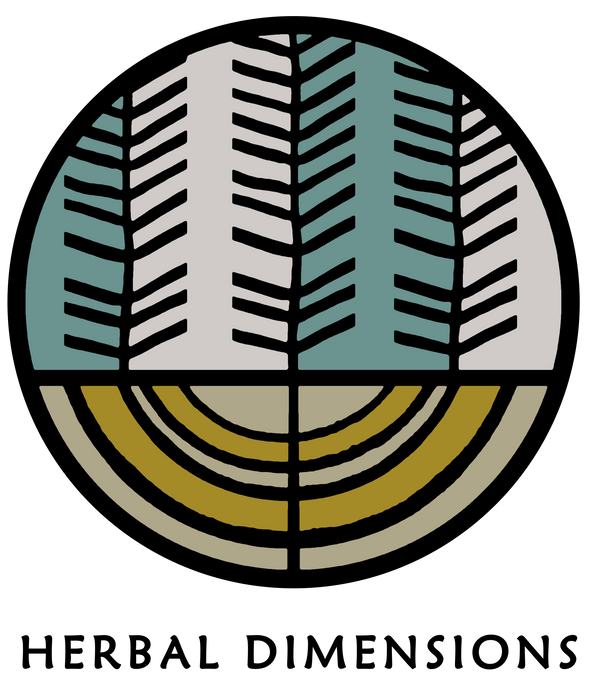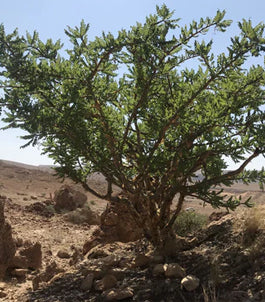Discovering the World of Incense Resins: An Insight into Yemen's finest
In the last couple years I have developed a fascination and love for incense resins (otherwise known as oleo-gum-resins). I love the variety and quality available and it has fast become one of my favourite study interests and collections here at Herbal Dimensions. Their exquisite aromas have the ability to elevate the spirit and calm the mind and yet these substances are not just captivating with their scents, but for their myriad of functional uses.
In this article I will introduce and explore some of the finest resins I have come across in my ethnobotanical studies, the incense resins of Yemen.
The resins discussed below are available to buy from Herbal Dimensions so don't forget to check out our shop to complete your collection!
Behind the Resins: Land, People, and Process
Whilst the world of incense resins is vast and intriguing, the core purpose of this article is to share with you a knowledge of the landscapes, the indigenous trees and the local people that bring these resins to us. Alongside the vibrant images I'll explore the botanical diversity, traditional uses and therapeutic applications of these resins.
During my exploration, I took the liberty of discussing these resins with our supplier in Yemen. Throughout this piece, I've interspersed our conversation, offering you insights straight from the source.
Frankincense (Boswellia sacra)
Most may recognise Frankincense through the nativity story and it's inclusion in such signifies its importance. Frankincense originates from various tree species in the genus Boswellia. It is a member of the family Burseraceae which gifts us other aromatic incense resins such as Myrrh, Copal and Palo Santo. It's etymology dates back to the old french 'franc encens' meaning 'high quality incense'. In China it is named Ru Xiang, in India as Salai guggul and 'Luban' in Arabic.
There are four main Boswellia species considered 'true' Frankincense; B.sacra, B.serrata, B.frereana & B.papyifera all with different and often overlapping geographical ranges.
The Frankincense varieties that I obtain from the the mainland of Yemen are from the same species; Boswellia sacra. As such I will focus on this species and explore the others in subsequent articles. I will also introduce a special kind obtained from Socotra Island, B.elongata.
Boswellia Sacra: A Resilient Tree with Rich Resin
Boswellia sacra is native to the Arabian peninsula, notably Yemen, Oman and also the horn of Africa, specifically Somalia. The tree itself is small (2-8m in height), deciduous, branched almost from ground level with light brown papery outer bark and a reddish-brown resiniferous layer. As some of the following images will illustrate, Boswellia sacra trees can tolerate some pretty harsh growing conditions!
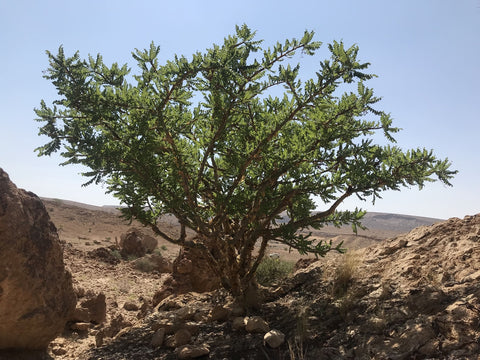
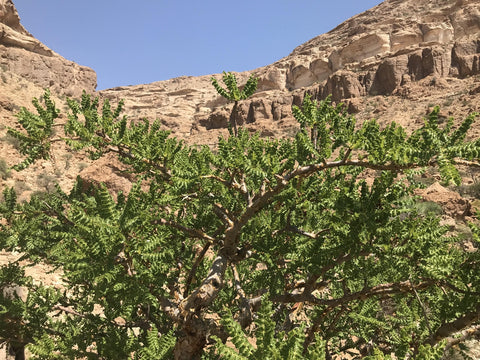
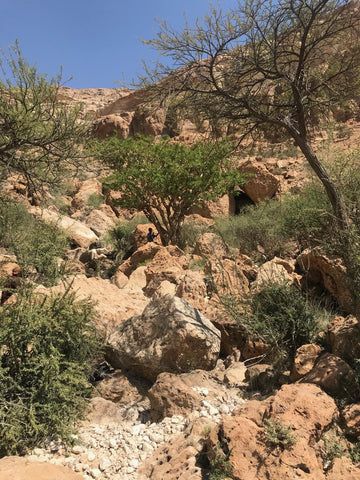
Frankincense trees in Yemen
Harvesting the Essence: The Art of Tapping
Frankincense resin exudes from the trunk and branches of the tree when a shallow incision into the bark is made. This is known as 'tapping' the tree. Trees produce such resins to rapidly seal wounds that can allow harmful fungal and insect agents entry. A Frankincense tree will become productive from about 8-10 years old. I have asked my supplier more about harvesting:
Me: Is there a 'season' for Frankincense and Myrrh harvesting?
Z: Frankincense in the valley of Hadaramout is harvested almost all year. A month after rainfall the yield of resin increases.
Me: Does the harvesting kill trees? Are Frankincense trees in decline in Yemen? Are trees planted?
Z: It is very seldom that Frankincense trees are killed in the whole of Yemen due to over harvesting. Yemenis share a true love for their ecosystem. Especially the Bedouins have a profound connection with their surroundings. Trees have been planted. I have already started with one tree as a pilot project. In the near future, I will be intensifying this effort. Due to the geopolitical situation in Yemen, Frankincense trees are more protected than ever. There is no trend of declines like in Somalia or Ethiopia.
Me: I'd also love to hear a bit more about the bedouin people that harvest these resins for you. Has this been a tradition for them for generations? How do they use Frankincense themselves? If you do not mind me asking, do they receive a fair price for their work?
Z: The bedouins I work with earn more than the ones serving the local market. The bedouins live a semi-nomadic life. Mostly they heard goats and hold camels. The modern bedouins mostly have lost track of a lot of traditions. For this reason, frankincense mostly was reduced as incense burnt on a daily basis. Only lately they have rediscovered the therapeutic benefits of the intake. There are some herbalists who have profound knowledge of a lot of local resins and herbs.
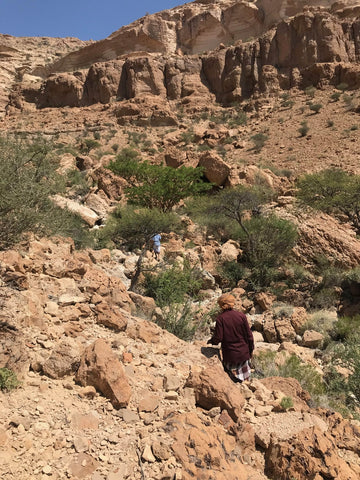

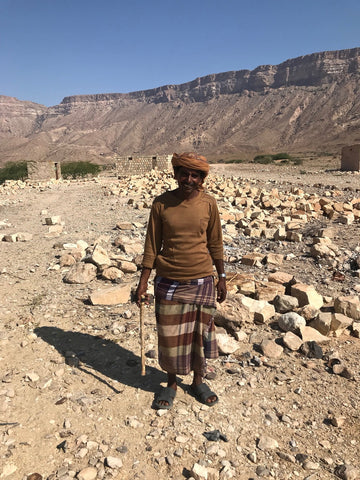
Bedouin men
Varieties
So, you will see there are some different Frankincense varieties available, For example from Yemen I obtain varieties we call Amber, Royal & Green Frankincense. What are these all about? I posed the following questions:
Me: With regard to Frankincense, could you tell me the difference between the different resin varieties? For example, what is the difference between green, amber & royal? Are they harvested at different times? From different types of trees? Is green the first 'virgin' harvest and then it gets darker? Or is there another reason ?
Z: The specimen of the frankincense tree is always the same; Boswellia sacra. The difference between green, royal, and amber are as follows; The first tapping of the bark yields darker resin. The more an area of the bark gets tapped the lighter the colour of the resin. The green colour resin is subject to rainfall, microclimate, and soil. After tapping the bark most yield of resin is dark then lighter (yellow & white) then a little green.
The Dhofar region in Oman is divided into four parts where the mostly wild frankincense trees are found. One of them is Al Hojari, where according to the Omanis the most valuable and prized frankincense comes from. Al Hojari frankincense resin has further more been graded by its colour and scent. Most precious is the green colour resin. You also get a white to yellowish and a darker amberish colour resin. Most arabs only grade the resin as light or dark in colour.
However the green frankincense is not only found in Oman. There are sources of green resin from Somalia, Nigeria and Yemen (just to name a few). There is a clear distinction of scent between the African and Arabian resin though. Back in the days of the famous incense trail the Dhofar region was part of Hadaramout. The Boswellia sacra trees from Yemen and Oman are therefore the same. The difference of aroma and quality of the resins is due to the differences in soil, climate and tapping method.
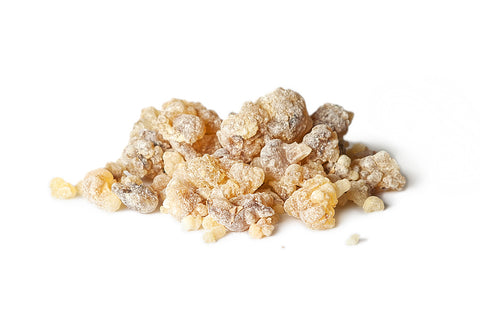
Amber resin, higher essential oil content, primary use as incense resin, aroma; musky deep pine & sweet citrus overtones.

Royal Frankincense resin, lighter in colour, incense or therapeutic, aroma; smooth, fresh citrus, reassuring!
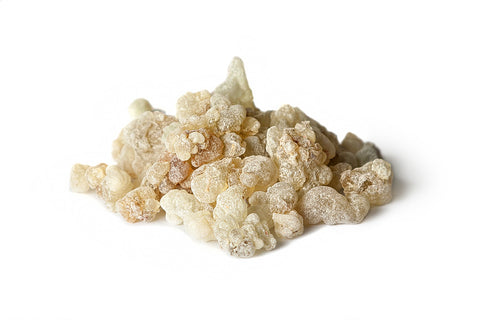
Green Frankincense resin, highest/rarest grade. Light with green hue, incense or therapeutic use. Aroma; sherbert lemon, smoothest and cleanest of all.
Me: I understand the green and royal grade can be used for consumption & therapeutic purposes? But the darker the resin the more essential oils and better as incense ? What is difference between green, royal and amber varieties in that regard?
Z: The darker resin is mostly used as incense due to the fact that it has more depth in its aromas because of the higher percentage of essential oils. Traditionally Arabs have preferred the lighter resin for therapeutic consumption. You can try to intake the amber resin, all-natural and with no side effects. However, the lighter resin is more pleasant. The boswellic acids are quite popular at the moment. However, you need to understand that these acids are not found in the essential oil. The boswellic acids are a compound of the gum-resin. Therefore the potency in the green and royal resin is higher.
Me: What medicinal qualities is frankincense used for traditionally and also what other modern/contemporary medicinal applications are you aware of? I will look up some of this but would love to hear your own knowledge on it.
Z: The lighter colour resin is often used as medicine. Traditionally Arabs take one or two drops of resin and dilute it in a jug of water over night. First thing in the morning they drink the milky coloured water.
The essential oil is anti-inflammatory. I have people using it for toothache, headache, and joint pain. In aromatherapy, essential oil is used to calm down and elevate spiritually. I have also tried the intake of essential oil. I experienced my digestive system responding in a positive manner. However, caution with the intake needs to be very little and not too frequent.
The more beneficial therapeutic method is to intake the whole compounds of the gum-resin. For example as a capsule. There is much information online about the beneficial properties of boswellic acids.
Therapeutic Wonders of Frankincense
Frankincense has been employed for its therapeutic potential since before written history. Its use was known in ancient Egypt and its use practiced in Indian Ayurveda and the Chinese herbal traditions for thousands of years for a variety of purposes.
In India B.serrata is used in the treatment of chronic inflammatory conditions including various arthritic, gastrointestinal and respiratory diseases. In China Frankincense has been used for invigorating the blood and moving Qi, as such it has been used for aiding wound healing, reducing swelling & bruising (such as the Dit Dar recipes of traditional Chinese martial arts). It has also been used to treat various skin conditions.
Modern scientific research has demonstrated anti-inflammatory, anti-arthritic, antimicrobial, immuno-modulatory, hypoglycemic, anticancer, anti-asthmatic, antidiarrheal, hypo-lipidemic, anti-diabetic, hepato-protective, and even antiviral effect of different Boswellia species.
Over 200 compounds have been isolated in resins from Boswellia species. Early and ongoing research has focused on the anti-inflammatory action of a group of compounds named boswellic acids. The literature suggests these do not act alone and there are inhibitory and synergistic influences between boswellic acids and other compounds that mediate the various actions in the body. These compounds also vary between Boswellia species, and will to some degree vary between tree and even batch. There is much more scope for further research into various aspects of Boswellia resins.
There is a wealth of information in both traditional herbal references as well as the modern scientific literature that is very much worth reading (see references section for a few at the bottom).
Socotran Frankincense (Boswellia elongata): An Island's Aromatic Gift
Socotra Island is located in the Indian ocean off the coast of the Arabian peninsula. It is part of the Republic of Yemen. It is known for it's high quantity of endemic species (a third of its plant species). One such species, Boswellia elongata is the source of Socotran Frankincense resin.
I took the opportunity to ask more about this rare species:
Me: Please tell me more about the Socotran Frankincense. Is this best used as an incense or can it be consumed for therapeutic purposes also? How does it compare to the other varieties with regards to medicinal quality?
Z: Yes, the elongata is endemic to Socotra. It is similar to the Boswellia frereana from Somalia. It is an oleoresin with very little gum. The Socotri's don't use the resin therapeutically. It's only used for incense. It is very rare due to the fact that there are only a few bedouins left harvesting the resin very irregular. This type of resin fully dissolves when heated due to the fact that there is close to no gum in the resin. Also the drops are small and almost completely dissolve when put into carrier oils.
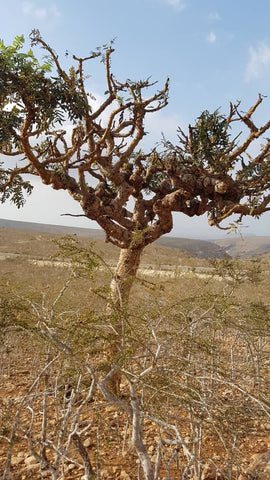
Boswellia elongata
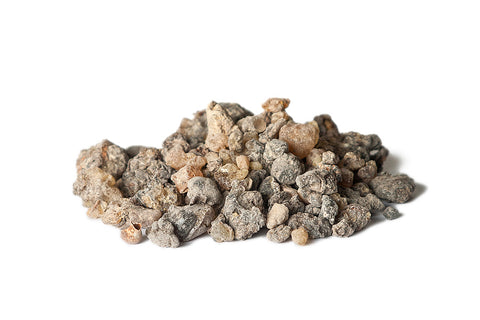
Socotran frankincense resin, musky pine undertones with light citrus overtone
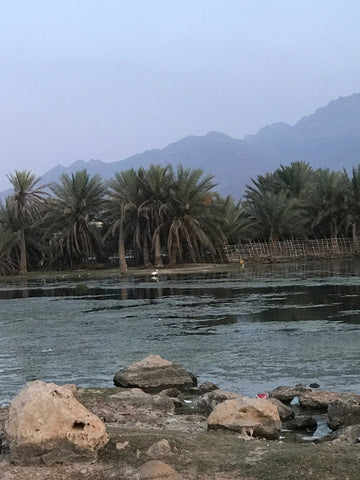
Socotra Island
Myrrh (Commiphora myrrha): A Scent from Arid Lands
In the aromatic family of Burseraceae, Myrrh is a prized sibling of Frankincense. The name Myrrh refers both to the tree and to its oleo gum resin. The name Myrrh can be translated from the Arabic 'mur' as meaning 'bitter'. Since antiquity it has been prized for it therapeutic, perfumery and incense properties.
Hailing primarily from arid biomes like deserts and dry shrublands, Commiphora myrrha is a native of places ranging from Djibouti and Ethiopia to Saudi Arabia and Yemen. It grows to about 4m in height and is very spiny. It has 2 layers of bark, an outer bark silvery, whitish or bluish grey, peeling in large or small papery flakes from the greener under-bark which is able to photosynthesise.
Much like Frankincense, Myrrh resin is obtained through cutting incisions into the bark resulting in the exudation of a solid, transparent yellowish gum-resin that crystallises in small clusters for collection.
Traditionally, Myrrh's repertoire of uses spanned from treating ailments like mouth ulcers, wounds, and stomach disorders to combating microbial infections and inflammation. For example, The documentations from British Herbal Pharmacopoeia showed Myrrh tincture usage as a mouthwash in gingivitis and ulcers.
For centuries In Ayurvedic medicine Commiphora guggul has been used (amongst other things) to treat arthritis. In fact clinical trials have shown significant improvements of osteoarthritis patients following treatment with a resin extract treatment of C.guggul.
Myrrh is widely used in the Chinese medical systems and China is the biggest Myrrh importing country. Due to its ability to break up coagulated blood and promote circulation it is commonly used in the treatment of fractures, inflammation of the joints, and trauma as well as sores and other skin conditions. It is often used alongside Frankincense due to its fascinating synergistic effects. It is also regarded as an important drug in the treatment of syphilis, leprosy, and rheumatism.
Modern scientific research has demonstrated Myrrh has a multitude of pharmacological properties including anti-inflammatory, antioxidant, anti microbial, neuro-protective, anti-diabetic, anti-cancer, analgesic, anti parasitic and also helpful in respiratory infection.
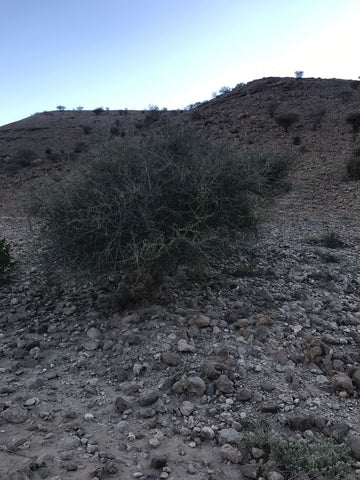
Commiphora myrrha tree
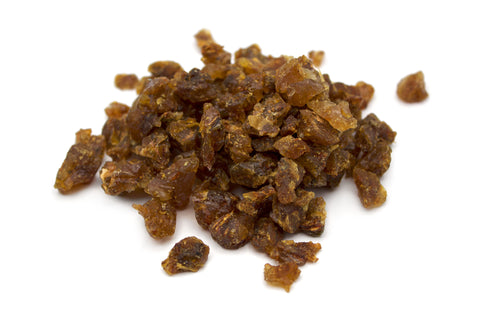
Myrrh resin, Yemense mainland
Socotran Myrrh (Commiphora socotrana)
Socotran Myrrh is a personal favourite and another endemic to Soctran Island. The resin emanates a rich red hue that you do not see in the mainland Myrrh. It has the most mesmerising aroma, incredibly rich and deep.
Me: With regard to Myrrh, what is the difference between Socotran Myrrh and other Myrrh found in Yemen?
Z: The Myrrh from Socotra is no "traditional" Myrrh. The scent is heavy musky, spicy warm and it has sedative properties. It is not as bitter as traditional myrrh and also is exceptionally clean. It is a potent natural antiseptic and quite rare. Traditionally it is not used therapeutically. It's perfect for incense as you might know. Myrrh from the mainland is very potent in its therapeutic use. You can dilute it in water and use it as a mouthwash or fungus treatment. Very very potent.
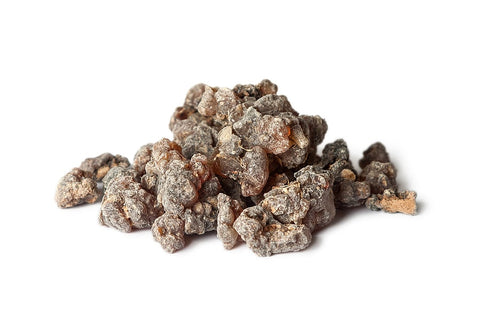
Socotran Myrrh resin, deep, warm, musky, spicy, otherworldly
Dragons blood (Dracaena cinnabari)
Dracaeana cinnabari is a tree in the family Asparagaceae. It stands tall as Socotra Islands endemic gem. Named after the red sap it produces, mimicing dragons blood.
The tree is unique in its appearance, a bare single trunk supports an umbrella shaped crown of tightly packed leaves that only grow from the youngest branches. See image below.
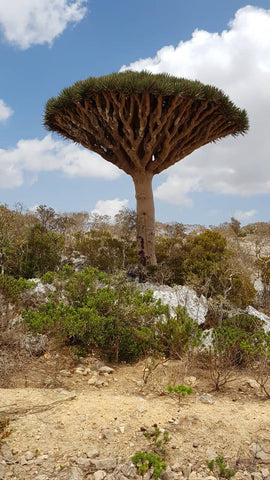
Various tree resins worldwide are labelled as Dragon's Blood.
The dragon's blood resin traded to Europe by the Ancient Greeks and Romans according to historians was from Socotra. It has no scent of its own due to the lack of essential oils. However once heated it develops a deep, sensuous, dark and strong amber and nutty scent. Usually one does not burn the resin alone, mostly its used in a mix especially with frankincense. Local Socotran people use it a lot as traditional medicine for the treatment of wounds, diarrhoea, eczema and ulcers in the mouth. Furthermore it is commonly used as dye and pigment for colour coatings.
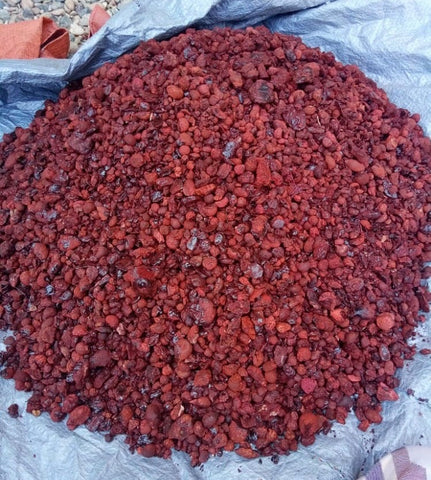

Dried Dragon's blood resin
In Closing: A Voyage Through Resinous Realms
The exploration into the world of resins fascinates me and yet I feel I have barely scratched the surface. The botanical universe holds a plethora of secrets, from ethnobotany and practical herbal applications to the intricate science of their therapeutic effects. While this article provides a brief overview, the journey has just begun. Stay tuned for deeper dives into the enchanting world of resins!
If you are interested in purchasing any of the resins mentioned in this article please check the following shop links:
Shop for Frankincense HERE
Shop for Myrrh HERE
Shop for Dragons Blood HERE
References
Boswellia sacra:
Kew Plants of the World Online:
https://powo.science.kew.org/taxon/urn:lsid:ipni.org:names:127065-1
Moussaieff, A. and Mechoulam, R. (2009), Boswellia resin: from religious ceremonies to medical uses; a review of in-vitro, in-vivo and clinical trials. Journal of Pharmacy and Pharmacology, 61: 1281-1293. https://doi.org/10.1211/jpp.61.10.0003
Rashan L, Hakkim F L, Idrees M, Essa MM, Velusamy T, Al-Baloshi M Al-Balushi BS, Al Jabri A, Al-Rizeiqi MH, Guillemin GJ, Abdo Hasson SS Anwer. Boswellia Gum Resin and Essential Oils: Potential Health Benefits − An Evidence Based Review. Int J Nutr Pharmacol Neurol Dis 2019;9:53-71. https://squ.elsevierpure.com/en/publications/boswellia-gum-resin-and-essential-oils-potential-health-benefits-
Shaden A.M. Khalifa, Safaa M. Kotb, Shaden H. El-Seedi, Lutfun Nahar, Satyajit D. Sarker, Zhiming Guo, Xiaobo Zou, Syed G. Musharraf, Amir Reza Jassbi, Ming Du, Hesham R. El-Seedi,
Frankincense of Boswellia sacra: Traditional and modern applied uses, pharmacological activities, and clinical trials,
Industrial Crops and Products,
Volume 203,
2023,
117106,
ISSN 0926-6690,
https://doi.org/10.1016/j.indcrop.2023.117106.
Me and Qi Traditional Chinese Medicine:
https://www.meandqi.com/herb-database/frankincense
Boswellia elongata:
Kew Plants of the World Online:
https://powo.science.kew.org/taxon/urn:lsid:ipni.org:names:127042-1
Commiphora Myrrha:
Kew Plants of the World Online:
https://powo.science.kew.org/taxon/urn:lsid:ipni.org:names:127741-1
Batiha GE, Wasef L, Teibo JO, Shaheen HM, Zakariya AM, Akinfe OA, Teibo TKA, Al-Kuraishy HM, Al-Garbee AI, Alexiou A, Papadakis M. Commiphora myrrh: a phytochemical and pharmacological update. Naunyn Schmiedebergs Arch Pharmacol. 2023 Mar;396(3):405-420. https://doi.org/10.1007/s00210-022-02325-0. Epub 2022 Nov 18. PMID: 36399185; PMCID: PMC9672555.
Commiphora kua:
Kew Plants of the World Online:
https://powo.science.kew.org/taxon/urn:lsid:ipni.org:names:913830-1
Commiphora socotrana:
Kew Plants of the World Online:
https://powo.science.kew.org/taxon/urn:lsid:ipni.org:names:127817-1/general-information
Dracaena cinnabari:
Plant of the Month: The Dragon Tree:
https://daily.jstor.org/plant-of-the-month-the-dragon-tree/
Deepika Gupta, Bruce Bleakley, Rajinder K. Gupta,
Dragon's blood: Botany, chemistry and therapeutic uses,
Journal of Ethnopharmacology,
Volume 115, Issue 3,
2008,
Pages 361-380,
ISSN 0378-8741,
https://doi.org/10.1016/j.jep.2007.10.018.
